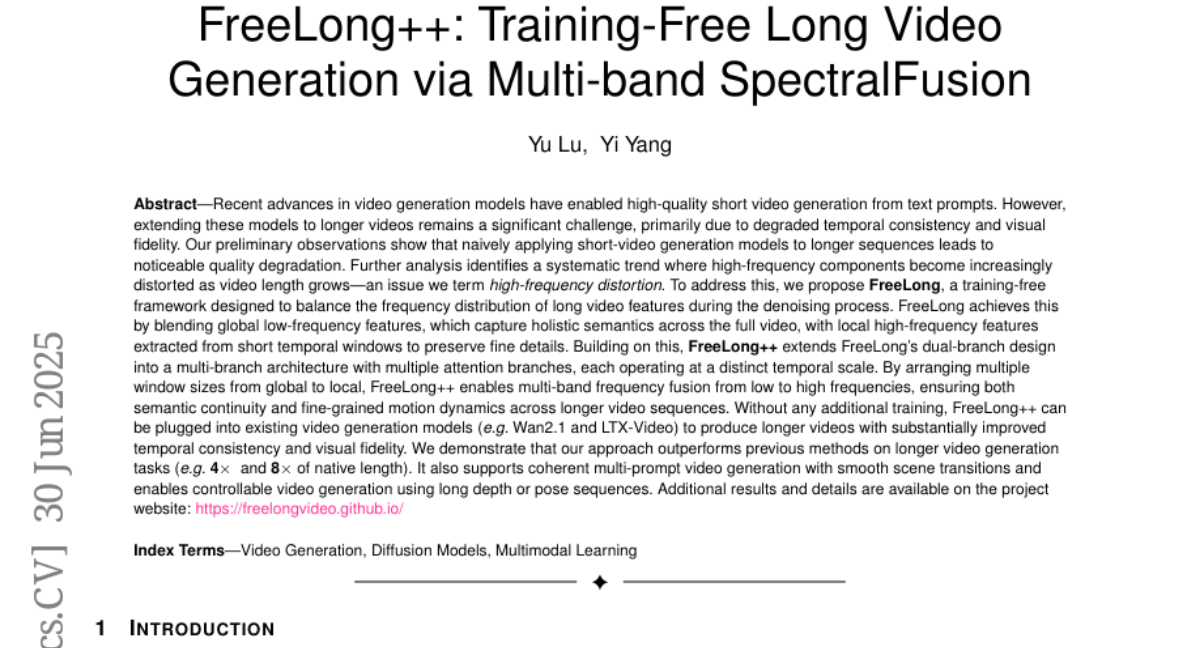AI Native Daily Paper Digest – 20250702
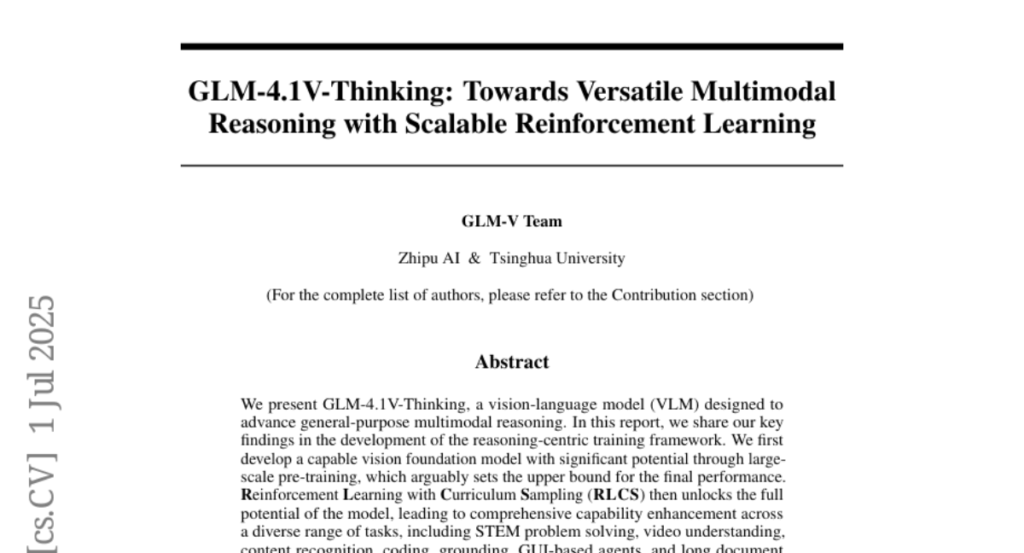
1. GLM-4.1V-Thinking: Towards Versatile Multimodal Reasoning with Scalable Reinforcement Learning
🔑 Keywords: Vision-Language Model, Reinforcement Learning, Multimodal Reasoning, Curriculum Sampling, General-Purpose
💡 Category: Multi-Modal Learning
🌟 Research Objective:
– Develop GLM-4.1V-Thinking to enhance general-purpose multimodal reasoning through large-scale pre-training and reinforcement learning.
🛠️ Research Methods:
– Utilized large-scale pre-training to develop a vision foundation model, followed by Reinforcement Learning with Curriculum Sampling (RLCS) to boost performance across diverse tasks.
💬 Research Conclusions:
– GLM-4.1V-9B-Thinking demonstrates state-of-the-art performance across various benchmarks, surpassing comparable models and even some significantly larger closed-source models in challenging tasks, underscoring its robust capabilities.
👉 Paper link: https://huggingface.co/papers/2507.01006
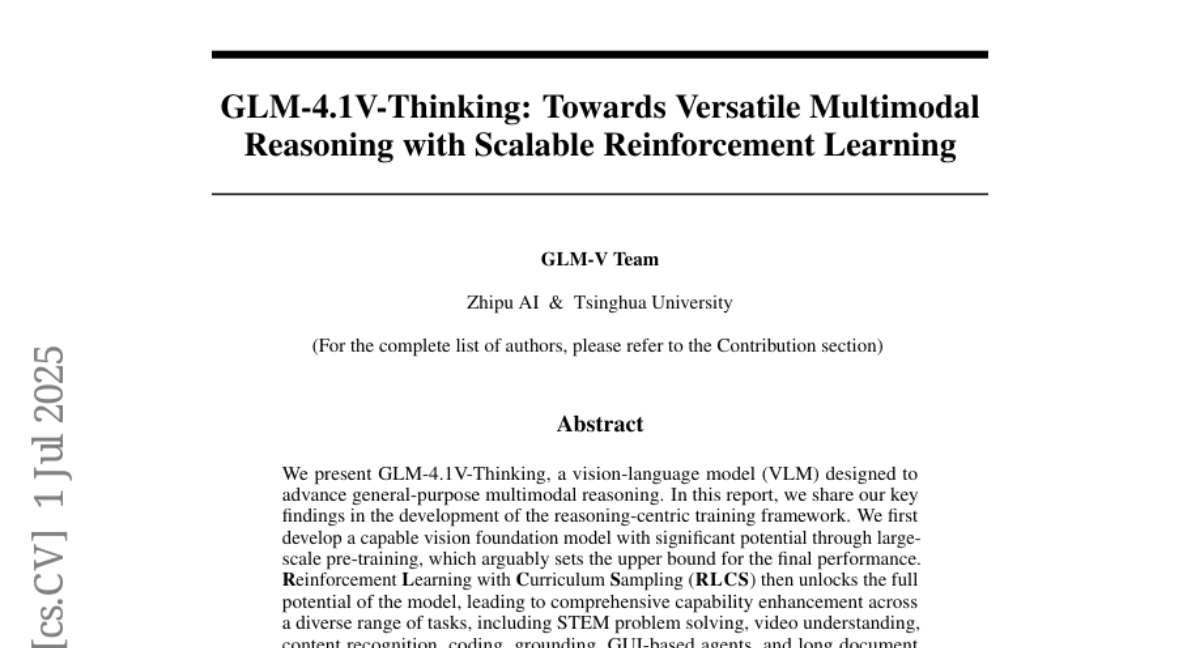
2. SciArena: An Open Evaluation Platform for Foundation Models in Scientific Literature Tasks
🔑 Keywords: SciArena, foundation models, community-driven evaluation, automated evaluation systems, meta-evaluation benchmark
💡 Category: AI Systems and Tools
🌟 Research Objective:
– SciArena aims to provide an open and collaborative platform for evaluating foundation models on scientific literature tasks, utilizing collective voting from the community.
🛠️ Research Methods:
– The platform engages the research community by collecting votes from trusted researchers across various scientific fields to perform peer comparisons and evaluate model performance in open-ended scientific tasks.
💬 Research Conclusions:
– Results indicate that submitted questions are diverse and representative of real-world literature needs, with strong self-consistency among researchers. The SciArena-Eval benchmark reveals challenges in automated evaluation, stressing the need for more reliable methods.
👉 Paper link: https://huggingface.co/papers/2507.01001
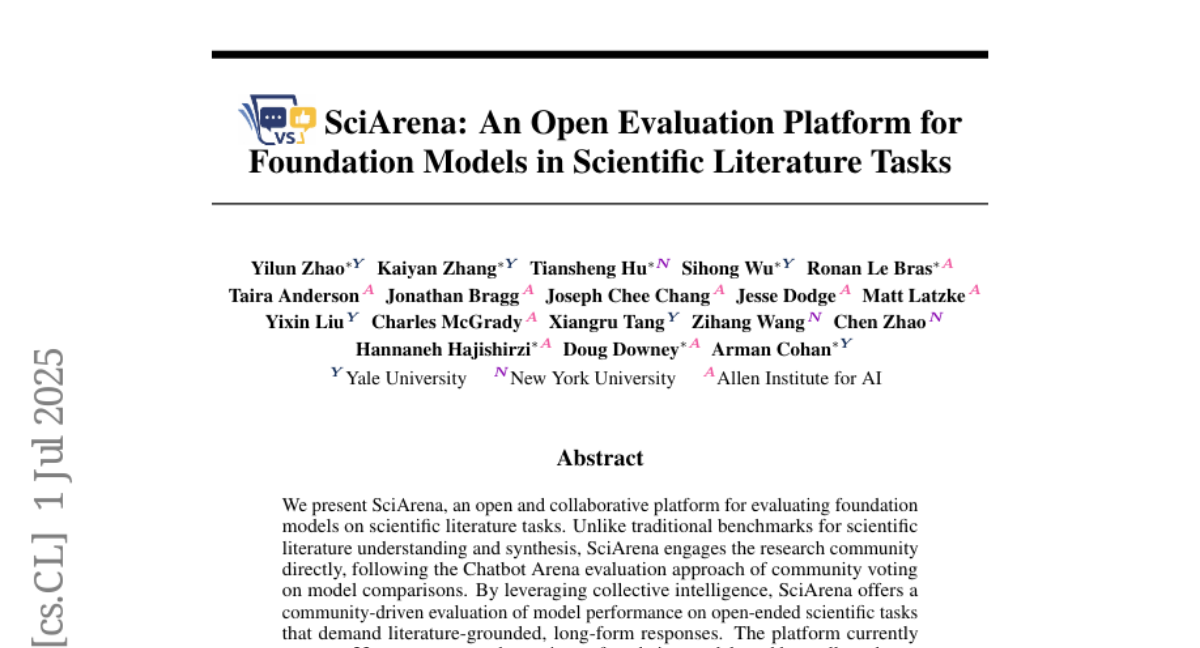
3. MoCa: Modality-aware Continual Pre-training Makes Better Bidirectional Multimodal Embeddings
🔑 Keywords: Multimodal embedding, Vision-Language Models, Bidirectional attention, Joint reconstruction objective, Massive unlabeled datasets
💡 Category: Multi-Modal Learning
🌟 Research Objective:
– The study aims to enhance pre-trained causal vision-language models for multimodal embedding by introducing bidirectional attention and scaling with unlabeled data through diverse training objectives.
🛠️ Research Methods:
– The research employs a two-stage framework called MoCa: Modality-aware Continual Pre-training and Heterogeneous Contrastive Fine-tuning for improving bidirectional multimodal embedding models.
💬 Research Conclusions:
– MoCa demonstrates performance improvements, consistently achieving state-of-the-art results across benchmarks like MMEB and ViDoRe-v2, showcasing strong scalability with both model size and training data.
👉 Paper link: https://huggingface.co/papers/2506.23115
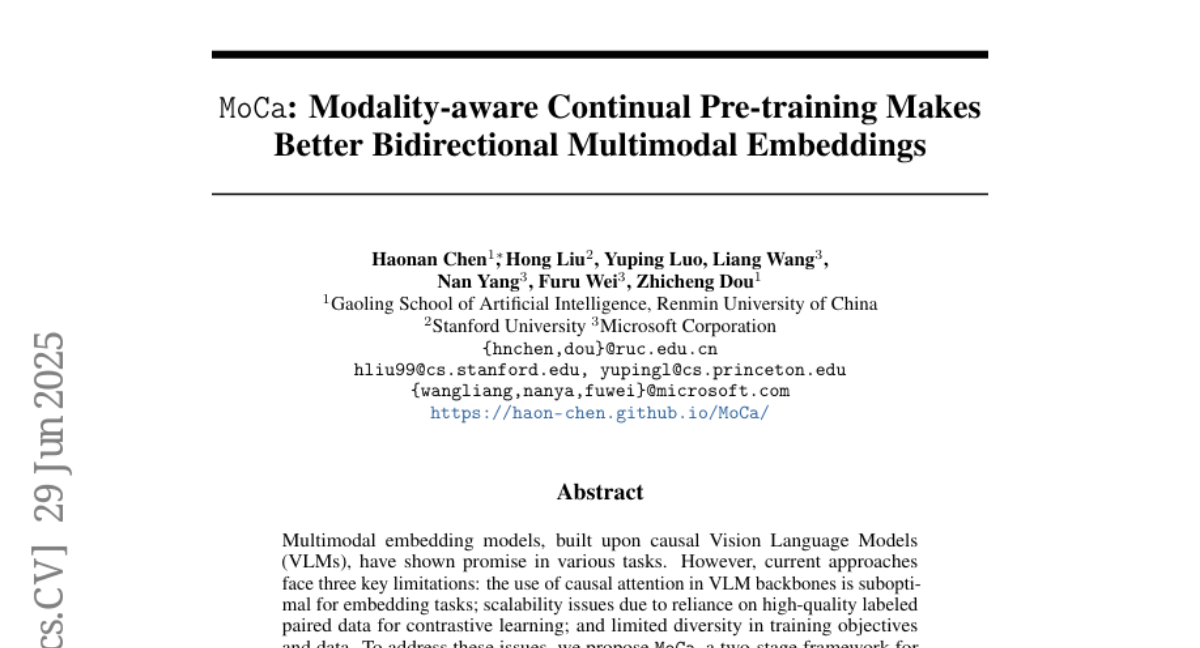
4. Does Math Reasoning Improve General LLM Capabilities? Understanding Transferability of LLM Reasoning
🔑 Keywords: Reinforcement Learning, Math Reasoning, Supervised Fine-Tuning, General-Domain Structure
💡 Category: Knowledge Representation and Reasoning
🌟 Research Objective:
– To evaluate the ability of different learning models, particularly comparing reinforcement learning with supervised fine-tuning, in generalizing mathematical problem-solving skills to a broader range of domains.
🛠️ Research Methods:
– Conducted controlled experiments on Qwen3-14B models using different tuning methods with math-only data, and analyzed latent-space representation and token-space distribution shifts.
💬 Research Conclusions:
– Reinforcement Learning-tuned models demonstrate better generalization across various domains, whereas Supervised Fine-Tuning-tuned models tend to forget general capabilities, indicating a need to reconsider the standard reliance on SFT in training reasoning models.
👉 Paper link: https://huggingface.co/papers/2507.00432
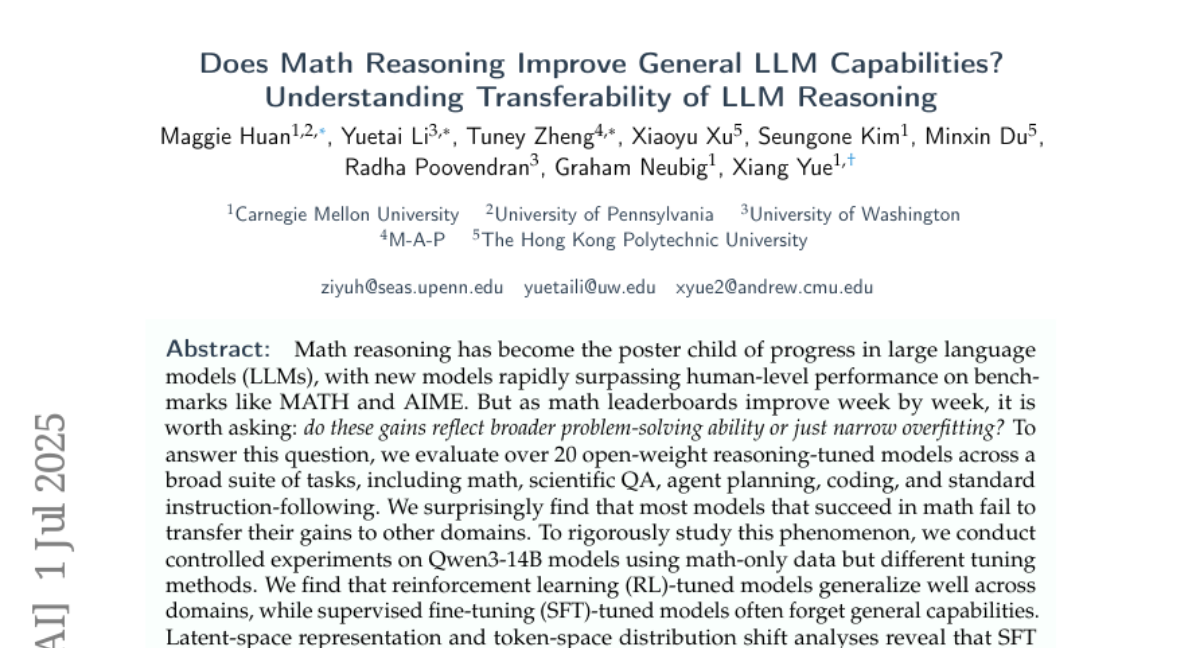
5. Radial Attention: O(nlog n) Sparse Attention with Energy Decay for Long Video Generation
🔑 Keywords: Radial Attention, Spatiotemporal Energy Decay, Diffusion Models, Video Generation, LoRA-based Fine-tuning
💡 Category: Generative Models
🌟 Research Objective:
– To introduce Radial Attention, a scalable sparse attention mechanism that improves efficiency and maintains video quality in diffusion models by utilizing spatiotemporal energy decay.
🛠️ Research Methods:
– Implementing Radial Attention with an O(n log n) complexity to efficiently manage computation based on the decay of energy, employing a static attention mask that reduces the attention window size with temporal distance.
💬 Research Conclusions:
– Radial Attention enhances video generation quality while achieving up to 1.9 times speedup and reducing training costs by up to 4.4 times without compromising the video’s integrity across various models such as Wan2.1-14B, HunyuanVideo, and Mochi 1. Enables video generation up to 4 times longer and accelerates inference by up to 3.7 times compared to existing dense attention methods.
👉 Paper link: https://huggingface.co/papers/2506.19852
6. DiffuCoder: Understanding and Improving Masked Diffusion Models for Code Generation
🔑 Keywords: Diffusion Large Language Models, Code Generation, Reinforcement Learning, Denoising Processes, Coupled-GRPO
💡 Category: Generative Models
🌟 Research Objective:
– Explore the decoding behavior of diffusion large language models in the context of code generation and determine their unique denoising processes.
🛠️ Research Methods:
– Conduct systematic investigation using a 7B diffusion large language model, DiffuCoder, trained on 130B tokens of code, incorporating the novel coupled-GRPO sampling scheme.
💬 Research Conclusions:
– Demonstrated that dLLMs, particularly DiffuCoder, can perform code generation more effectively by employing non-autoregressive denoising processes, resulting in improved performance on code generation benchmarks and reduced reliance on AR causal techniques.
👉 Paper link: https://huggingface.co/papers/2506.20639
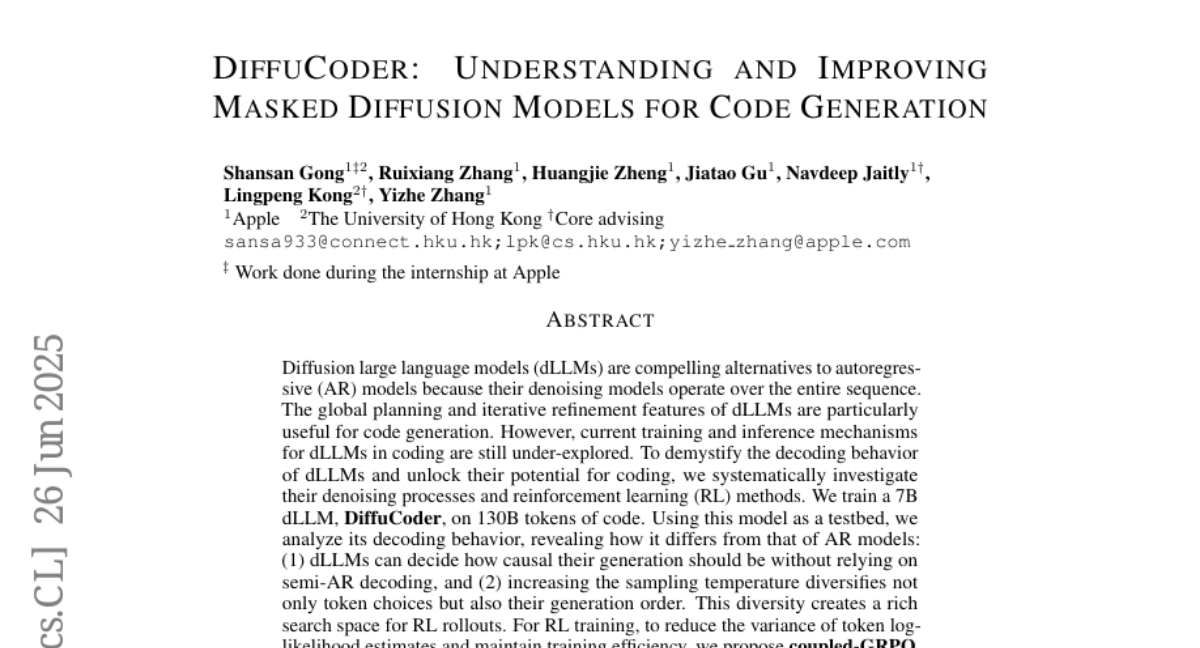
7. HumanOmniV2: From Understanding to Omni-Modal Reasoning with Context
🔑 Keywords: Reinforcement Learning, Multimodal Reasoning, Global Context Understanding, Shortcut Problem, IntentBench
💡 Category: Multi-Modal Learning
🌟 Research Objective:
– Enhance multimodal reasoning by addressing context understanding and shortcut problems using reinforcement learning.
🛠️ Research Methods:
– Introduce context, format, accuracy, and logical rewards evaluated by large language models to improve reasoning capabilities and integration of multimodal information.
💬 Research Conclusions:
– Proposed method achieves superior performance on the IntentBench benchmark, highlighting its effectiveness in understanding complex human intentions and emotions compared to other open-source models.
👉 Paper link: https://huggingface.co/papers/2506.21277
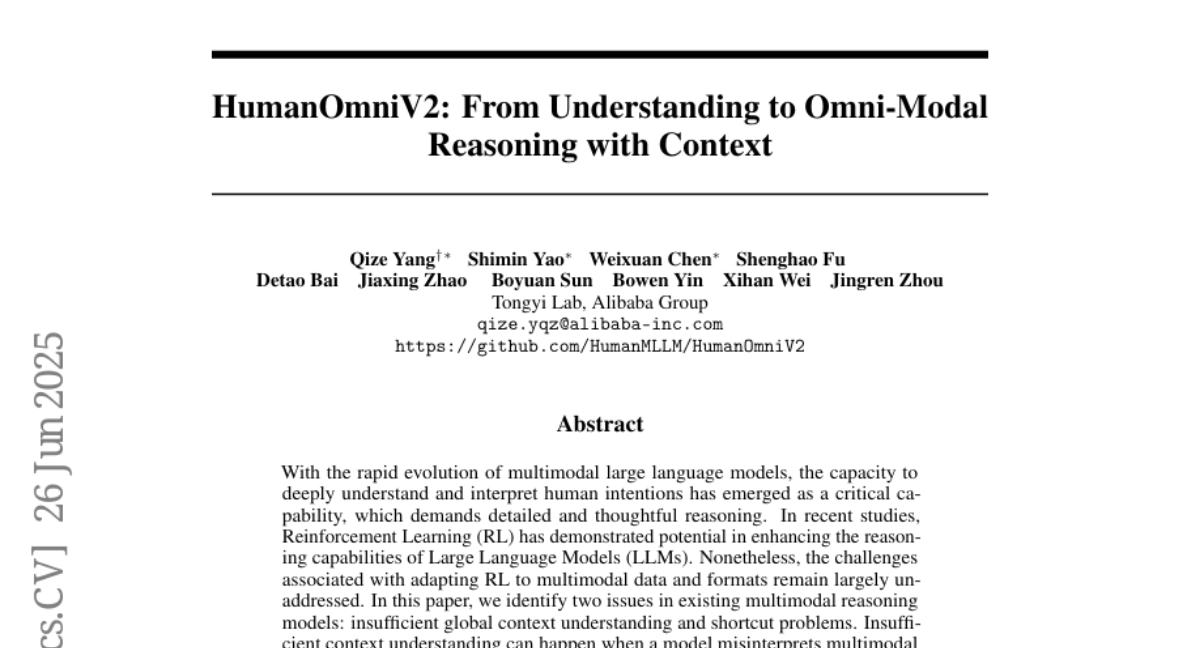
8. Training for X-Ray Vision: Amodal Segmentation, Amodal Content Completion, and View-Invariant Object Representation from Multi-Camera Video
🔑 Keywords: Amodal Segmentation, Multi-Cameras, Object Detection, Deep Learning, Computer Vision
💡 Category: Computer Vision
🌟 Research Objective:
– Introduce MOVi-MC-AC, which enhances amodal segmentation by using object context from multi-camera views of a scene.
🛠️ Research Methods:
– Simulate cluttered scenes with generic household objects in multi-camera video to provide consistent object identifications and segmentations.
💬 Research Conclusions:
– MOVi-MC-AC sets a new benchmark in the amodal dataset field by contributing labels for ~5.8 million object instances and providing the first ground-truth amodal content.
👉 Paper link: https://huggingface.co/papers/2507.00339
9. Thinking Beyond Tokens: From Brain-Inspired Intelligence to Cognitive Foundations for Artificial General Intelligence and its Societal Impact
🔑 Keywords: Artificial General Intelligence, modular reasoning, multi-agent coordination, neurosymbolic systems, reinforcement learning
💡 Category: Foundations of AI
🌟 Research Objective:
– The paper aims to synthesize an interdisciplinary approach to achieving Artificial General Intelligence by addressing current model limitations.
🛠️ Research Methods:
– The study integrates principles from cognitive neuroscience, psychology, and agent-based systems, emphasizing modular reasoning, memory, and multi-agent coordination.
💬 Research Conclusions:
– AGI development relies on integrating architectural and cognitive foundations such as memory and reasoning, with advances in neurosymbolic systems and reinforcement learning to overcome token-level prediction limitations.
👉 Paper link: https://huggingface.co/papers/2507.00951
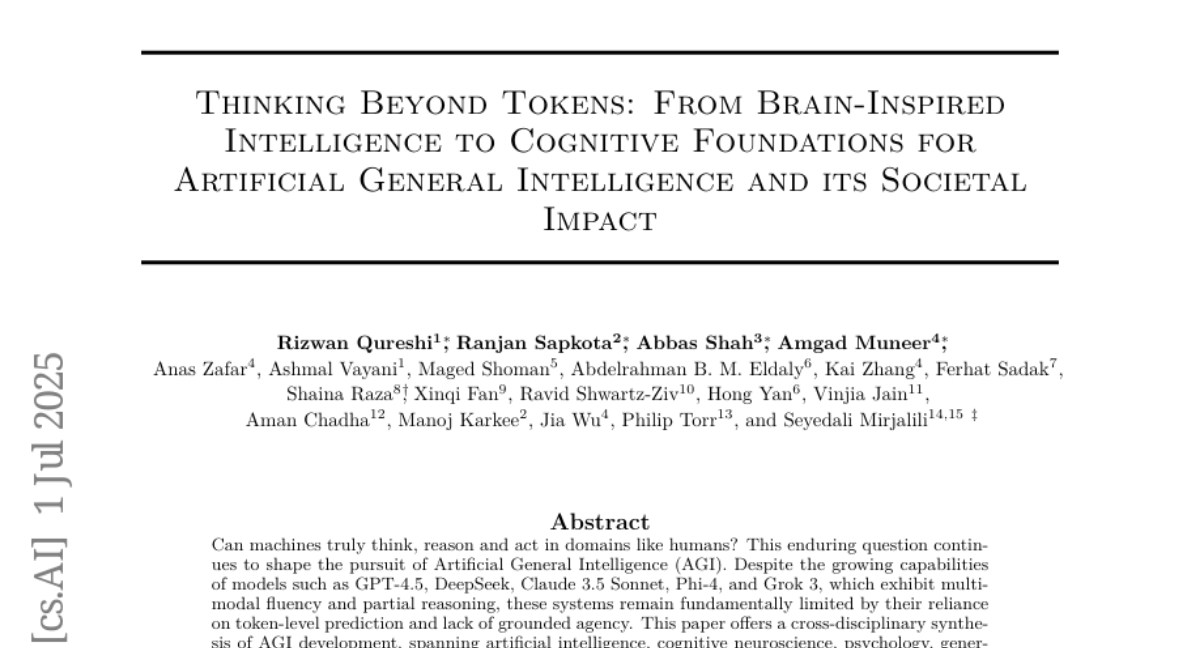
10. Data Efficacy for Language Model Training
🔑 Keywords: DELT, Data Efficacy, Data Scoring, Data Ordering, Language Models
💡 Category: Natural Language Processing
🌟 Research Objective:
– To enhance language model performance through a new paradigm called DELT, focusing on data efficacy by optimizing the organization of training data.
🛠️ Research Methods:
– Introduction of DELT, which includes components such as Data Scoring with Learnability-Quality Scoring (LQS) and Data Ordering with Folding Ordering (FO).
💬 Research Conclusions:
– DELT significantly improves language model performance without increasing data size by optimizing data organization.
– The combination of LQS and FO yields the most substantial performance gains.
– Data efficacy and data efficiency can be achieved simultaneously, indicating a promising direction for foundational language model training research.
👉 Paper link: https://huggingface.co/papers/2506.21545
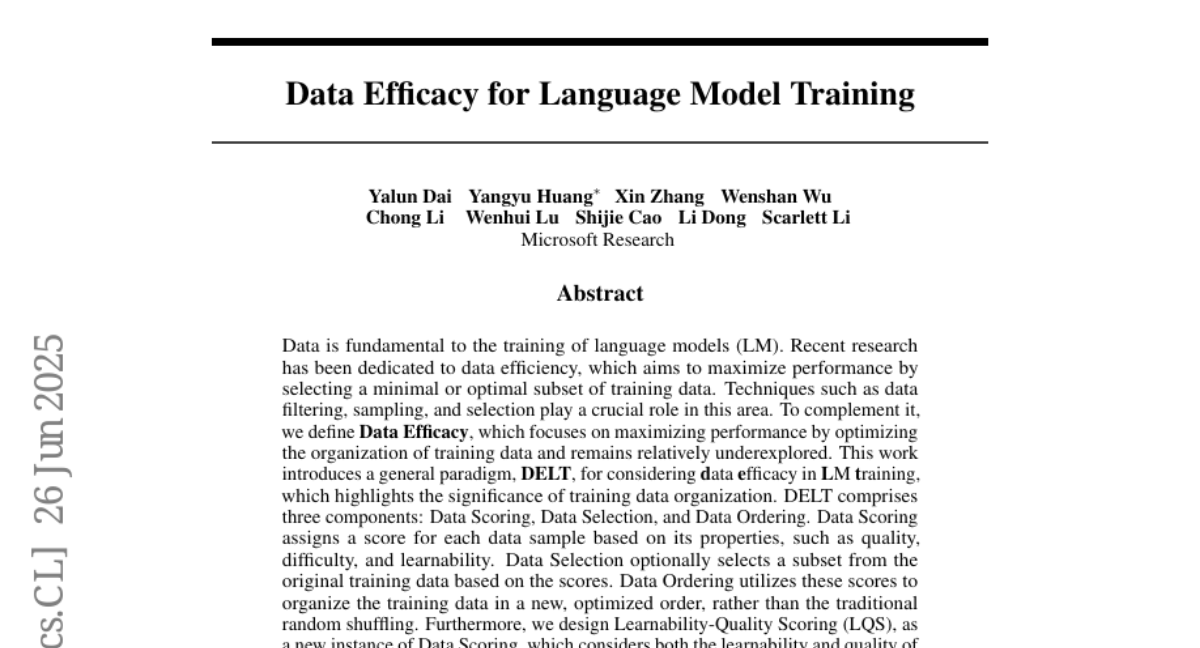
11. MusiXQA: Advancing Visual Music Understanding in Multimodal Large Language Models
🔑 Keywords: Multimodal Large Language Models, Music Sheets, Visual QA, MusiXQA, Phi-3-MusiX
💡 Category: Multi-Modal Learning
🌟 Research Objective:
– Introduce and evaluate MusiXQA, a comprehensive dataset designed to advance MLLMs in understanding music sheets.
🛠️ Research Methods:
– Created high-quality synthetic music sheets with structured annotations for diverse visual QA tasks.
– Fine-tuned an MLLM, named Phi-3-MusiX, on the MusiXQA dataset for enhanced music sheet interpretation.
💬 Research Conclusions:
– Current state-of-the-art MLLMs have significant limitations in music sheet understanding.
– Phi-3-MusiX achieves major performance improvements over existing GPT-based methods, setting a foundation for future advancements in this area.
👉 Paper link: https://huggingface.co/papers/2506.23009
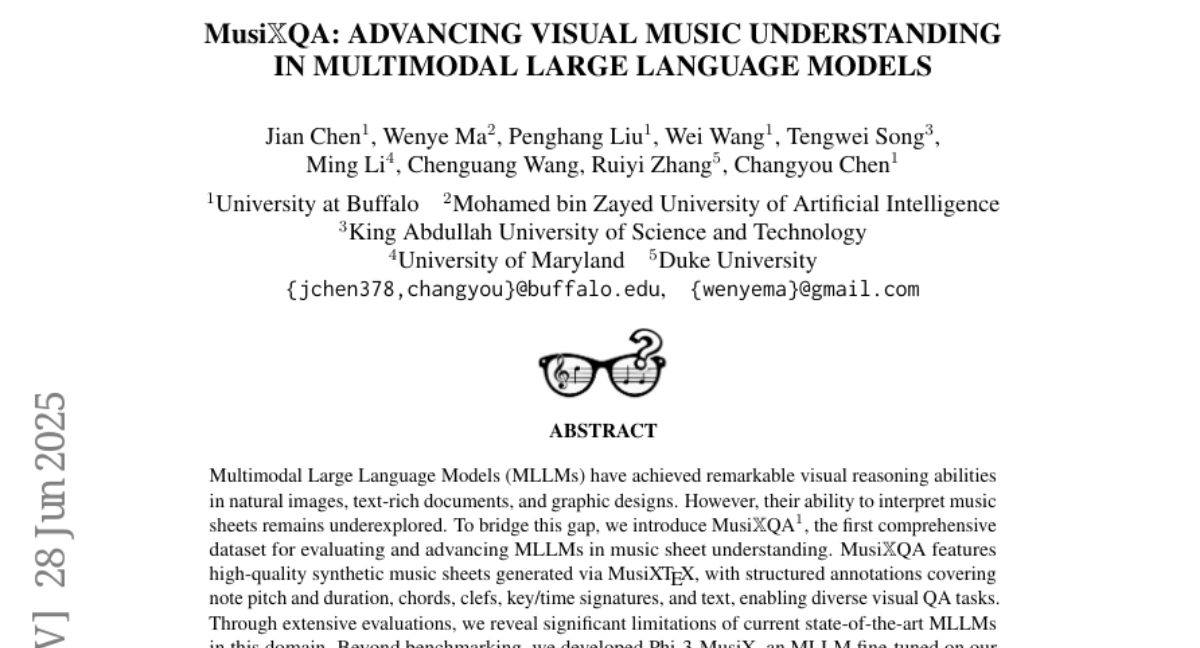
12. IR3D-Bench: Evaluating Vision-Language Model Scene Understanding as Agentic Inverse Rendering
🔑 Keywords: Vision-Language Models, Tool-Using Generative Capacity, Agentic Inverse Rendering
💡 Category: Computer Vision
🌟 Research Objective:
– To evaluate Vision-Language Models’ (VLMs) ability to understand and recreate 3D scenes from visual inputs using a new benchmark, IR3D-Bench.
🛠️ Research Methods:
– Introduction of IR3D-Bench, a benchmark focusing on programming and rendering tasks for Vision-Language Agents (VLAs) to actively create and demonstrate scene understanding via “understanding-by-creating”.
💬 Research Conclusions:
– Initial experiments reveal VLMs’ limitations in visual precision when performing agentic inverse rendering, despite their effective basic tool usage, showcasing the need for improved tool-using generative capabilities.
👉 Paper link: https://huggingface.co/papers/2506.23329
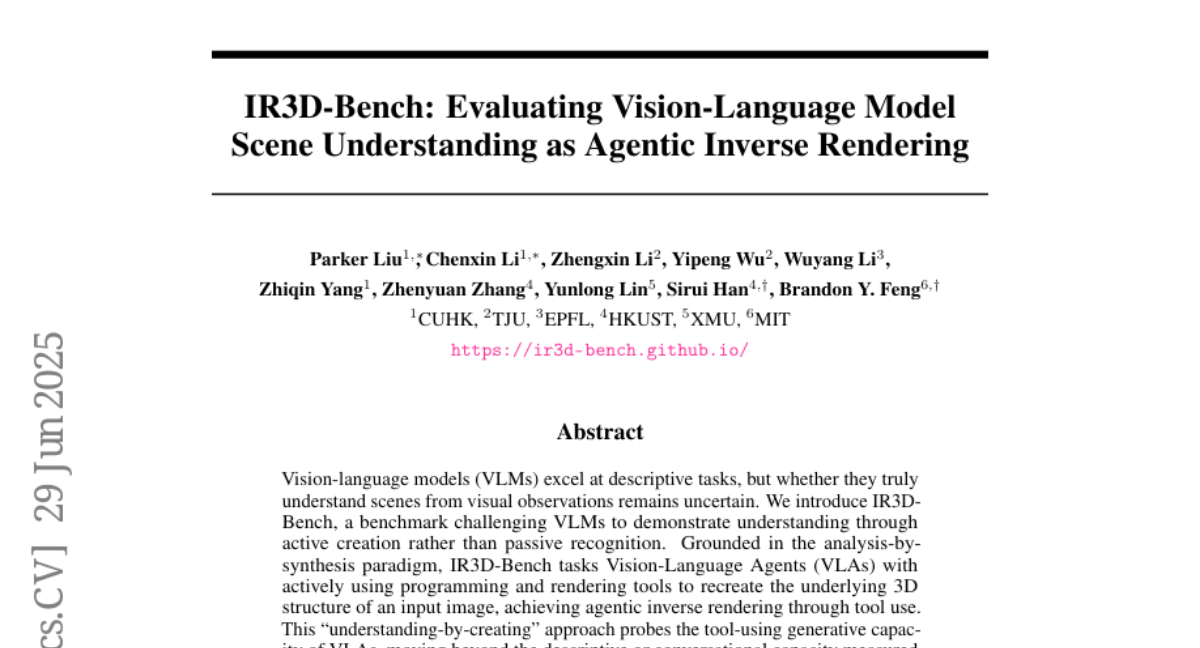
13. FreeLong++: Training-Free Long Video Generation via Multi-band SpectralFusion
🔑 Keywords: Video Generation, Temporal Consistency, Visual Fidelity, FreeLong, Multi-Branch Architecture
💡 Category: Generative Models
🌟 Research Objective:
– The study aims to address the challenge of generating high-quality long videos from text prompts by improving temporal consistency and visual fidelity.
🛠️ Research Methods:
– Proposed FreeLong, a training-free framework, which balances frequency distribution in long video features by integrating global low-frequency and local high-frequency features.
– Introduced FreeLong++, extending the dual-branch design into a multi-branch architecture for enhanced multi-band frequency fusion via distinct temporal scales.
💬 Research Conclusions:
– FreeLong++ significantly enhances temporal consistency and visual fidelity in long videos without additional training.
– The approach supports smooth scene transitions and coherent multi-prompt video generation, outperforming previous methods in longer video generation tasks.
👉 Paper link: https://huggingface.co/papers/2507.00162
